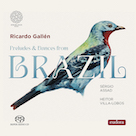

Ricardo Gallén: Preludes and Dances from Brazil
Eudora
Records
Musicianship is at an exceptionally high level on this homage to Brazil by renowned Spanish guitarist Ricardo Gallén. In coupling Heitor Villa-Lobos's Préludes and the Suite populaire brésilienne with Sérgio Assad's Colloquial Preludes, Gallén shows impeccable taste in his programming choices, and the fact that the latter work was composed for the guitarist and appears in its first recording makes the set all the more special. Testifying to the admiration and respect he has for Gallén and his artistry, Assad (b. 1952) also contributed liner notes to the release.
Gallén's reputation precedes him. A graduate of the Universities of Munich and Salzburg and Munich's Hochschule für Musik und Theater and currently a professor at the HFM “Franz Liszt” in Weimar, Germany, the guitarist has performed throughout the world, received over twenty international prizes, and issued a number of recordings, including ones on Naxos featuring music from Takemitsu and Bach to Brouwer and Rodrigo. Recorded in the 13th Century Convent of San Francisco in Ávila, Spain, the new recording reflects the experience that years of playing have brought him.
As Assad notes, Villa-Lobos (1857-1959) celebrated Brazil's cultural heritage by weaving elements of Brazilian folklore and traditional music into his writing. Illustrating the richness of his work, the Suite populaire brésilienne not only features Brazilian musical elements but weds them to European dance forms like the mazurka and waltz. While Assad's Colloquial Preludes partners well with Villa-Lobos's own preludes and suite, his twelve preludes venture farther afield in their explorations, the result a multi-dimensional collection that offers fascinating points-of-comparison between the two composers. No matter the differences in style and sensibility, Gallén brings equivalent degrees of conviction, insight, and authenticity to performances that truly do get to the heart of the matter.
Each of the twelve Colloquial Preludes is in a different key, and, as Assad clarifies, open strings are used to promote resonance and ease of playing. They're statements of concision that make their cases with dispatch and then step aside for the next in the series. The artfulness of Gallén's attack is evident the moment the C major prelude initiates the work with fleet-fingered fretwork and precise articulation. The A minor and E minor preludes are slower by comparison, and their contemplative character highlights the sensitivity of the guitarist's touch and personalized phrasing (the eloquence of his E minor rendering merits extra mention). Taken at a furious clip is the G major prelude, which also adds percussive effects to the light-speed runs Gallén delivers so dazzlingly. The also-torrential D major and dizzying A major preludes are distinguished by fingerpicking of an extraordinary order. Whereas the wistful B minor eighth unfolds like a beguiling folk tale with a compelling story to tell, the F sharp minor tenth uses harmonics to amplify its meditative aura. A lyrical quality marks the sweetly singing E major eleventh, after which the C sharp minor ushers the work to a peaceful end (its dramatic closing flourish aside). Contrasts in tone and tempo emerge throughout, making for an always commanding listening experience.
Five preludes by Villa-Lobos follow, two in E minor and the others E major, A minor, and D major. A haunting tone is established by the first E minor setting, which traverses a wide territorial range in its five evocative minutes. The composer's melodic gifts are on full display in the set, be it in the entrancing lilt of the E major second or the probing introspection and romantic melancholy of the A minor third. In a poised treatment, Gallén convincingly conveys the sadness of the second E minor prelude, after which the D major fifth brings the piece to a gently sunny resolution. The five-part Suite populaire brésilienne instantly enchants with “Mazurka-Choro,” melody again an alluring component, and then sustains the spell with the plaintive “Valsa-Choro,” ravishing “Gavotta-Choro,” and lively “Chorinho (Petit-Choro).”
In presenting material by two composers, Gallén's recording doesn't aspire to document Brazilian classical music in its entirety. It does, however, succeed in offering a sampling of the captivating material artists such as Assad and Villa-Lobos have shared with the world. As importantly, the recording provides a terrific account of Gallén's considerable artistry as a player, curator, and interpreter.May 2025